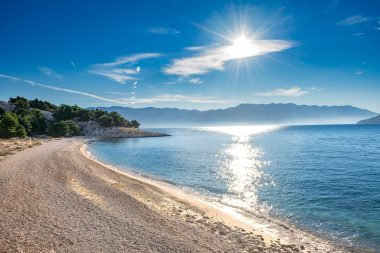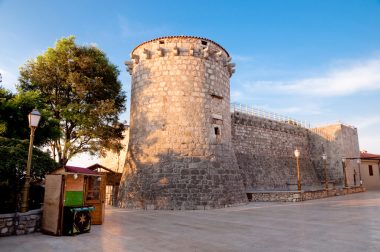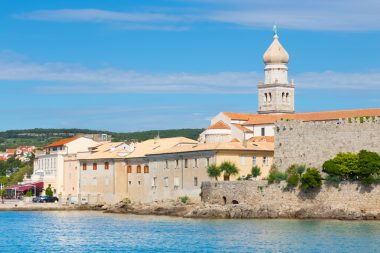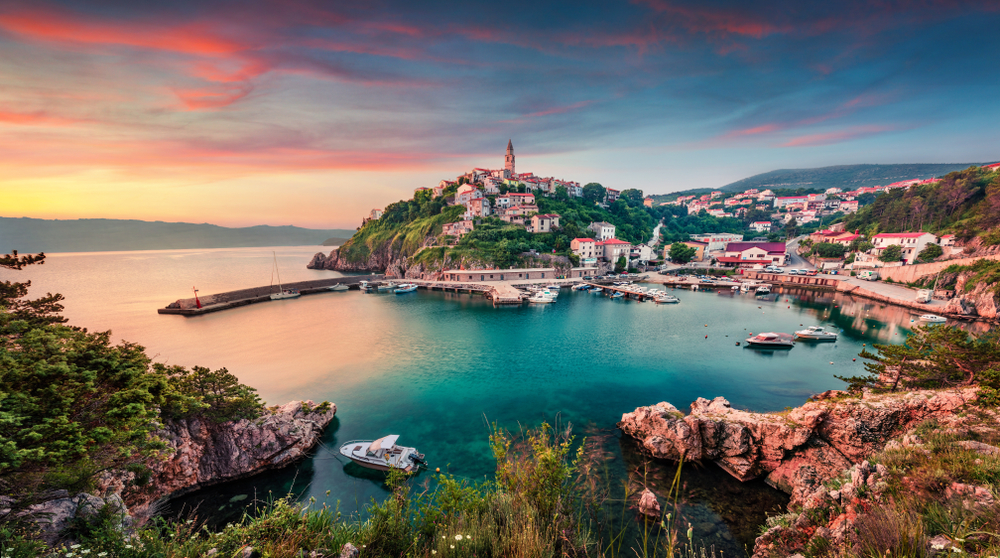Krk is the largest holiday island in the Adriatic. It is connected to the Croatian mainland by a bridge. Guests love the diverse excursion destinations, the azure blue sea and the tranquil bays. The history of the island is also interesting: the first settlers were the Japods. Later, during the Roman Civil War, the island became the scene of bloody naval battles between Caesar and Pompey. A lot has happened since then. Krk has opened up to tourism and welcomes new travellers in an open-minded and extremely friendly manner. Breathtaking flora and fauna skilfully round off your stay on Krk. See for yourself!
Bathing fun for the whole family

For the Croats living on Krk, May 1 is an important day of the year. Swimming is then the order of the day on the island’s 100 beaches. Although the water temperature can still be a cool 16 degrees at this early stage, the locals love their tradition. In the following weeks, when the sun sinks lower and lower, temperatures rise to up to 30 degrees.
The best conditions for an extensive beach holiday – and there are really enough beaches on Krk! Along the 220-kilometre-long coastline, holidaymakers will find the best beaches in Krk. Here, fine sandy beaches alternate with dreamlike pebble beaches. A real insider tip is the beach in the small village of Silo. It is one of the most pristine beaches on the island. There is another special feature in Soline. The bay is located in the northeast of the island and is known for its healing mud. Here you will find the pretty resorts of Cizici, Soline, Klimno and Dobrinj. If you want to experience Krk from the water, Punat is the place to be. Punat has a large harbour where countless recreational yachts and sailing boats are moored. A true paradise for hobby captains!
Probably the most popular beach is in the village of Baska. The two-kilometre-long fine pebble beach offers the best bathing conditions. In addition, the coastal town has a lot to offer tourists. Restaurants, bars and souvenir shops are lined up here and provide a varied entertainment programme. In the evening, people meet on the terraces along the waterfront and relax and review the day with a glass of wine.
Flora and fauna

Large parts of the island of Krk are barren. Here, local farmers only let spies and goats graze. Nevertheless, there are about 1,300 plant species on Krk. In addition, 220 species of birds and an incredible 852 species of butterflies feel at home on the island. Many migratory birds fleeing from the cold winter to the south rest on Krk. One bird species stays on Krk to breed. Griffon vultures use the cliffs in the southeast of the island to build their nests. It was declared a bird sanctuary in 1969. But there is another special feature on Krk. The landscape of the municipality of Vrbnik is different from the rest of the island.
Here, the soils are much richer in nutrients. Locals recognized this. They came up with the idea of producing their own wine. What started as a crazy idea has developed into a real success model. Today, the white wine variety Žlahtina is grown, harvested and processed into wine exclusively on the island. Guests can experience another natural spectacle when visiting the Vitezić Cave. According to legend, the stalactite cave houses an undiscovered treasure. The cave is divided into five halls and is home to rare animal species and impressive rock formations. In the high season, sightseeing tours into the interior of the cave take place every half hour. Thanks to professional illumination, you can see the special features of the cave at a glance.
Krk – capital with cultural monuments worth seeing

Krk’s capital Krk is located on the Kvarner Bay. Just 28 kilometres from Rijeka, it forms the cultural and economic centre of the island. The 4,500 inhabitants appreciate the advantages of their hometown: from the modern Riva waterfront promenade, you can reach the historic old town. This is surrounded by a city wall that is over 2,000 years old. Even the walk through the medieval city gate is an experience! The heart of the old town is the square “Vela Placa”. Here you will find many shops, noble boutiques, cozy coffee houses, ice cream parlors and restaurants. The most famous sights of the city are the Frankopan Fortress and the bell tower of the St. Quirinus Cathedral.
The Romanesque church building was built in the second half of the 5th century and is the cultural heritage of the island. In 1714, the roof of the bell tower was severely damaged in a violent thunderstorm that swept across the island. During the renovation work, a wooden angel from Venice was attached to the bell tower. He was supposed to protect the cathedral from further disaster. In 1973, this was unfortunately replaced by a plastic angel. In the summer months, classical concerts and jazz festivals are held on Kamplin Square.
Mediterranean island cuisine
In addition to international classics such as pizza, pasta and Wiener Schnitzel, there are also typical restaurants on Krk that still cook according to traditional recipes. In addition to freshly caught fish prepared on the grill, lamb specialties are typical of the island. Croatians also love goulash. The tender meat is traditionally eaten with surlice pasta. You can enjoy a glass of red wine with it. It gets sweet with dessert; Pancakes are not only one of the most popular desserts in Austria . You can also try a piece of Croatian cream cake, which makes your mouth water just by looking at it. Uštipci, on the other hand, are small dough balls that, similar to quark balls, are fried in hot fat and then rolled in sugar.
Getting to Krk
By car: The scenic drive over the Krk Bridge
One of the most popular ways to reach Krk is by car. You can travel comfortably with your own vehicle or a rental car from your hometown. The spectacular Krk Bridge connects the island to the mainland and is an absolute highlight. The 1430-meter-long bridge not only offers an impressive view, but is also a masterpiece of engineering. The tolls for the bridge are affordable, and you can make your trip at your own pace.
By plane: Rijeka Airport
Another convenient way to get to Krk is by plane. Rijeka Airport (RJK) on the island of Krk offers flight connections to various European cities. You can book a direct flight to Rijeka Airport and then quickly get to your desired vacation spot on the island. The airport is modern and well-equipped, which makes getting there extremely comfortable.
By ferry: A scenic lake route
For those who love adventure and want to experience the beauty of the Croatian coast, traveling by ferry is a great option. There are ferry services from various coastal towns in Croatia, such as Rijeka and Zadar, to Krk. During the ride, take in the scenic views of the azure waters and coastal landscape. The crossing takes about 1 to 2 hours, depending on the place of departure and the shipping company.
By bus: An affordable option
If you’re looking for a cost-effective way to get to Krk, getting there by bus is an option. There are regular bus services from various cities in Croatia and other European countries to Krk. The buses are comfortable and offer a relaxed travel option while you can admire the scenery.
Questions and answers about Krk
Where is Krk?
Krk is an island in the Adriatic Sea and belongs to the Republic of Croatia. It is located in the northern Adriatic Sea, east of Italy and west of Croatia on the European mainland. The island of Krk is located in the Kvarner Bay and is connected to the mainland by a bridge. The exact geographic coordinates of Krk are roughly between 45.0259 degrees north latitude and 14.5711 degrees east longitude.
How long is the bathing season on Krk?
The bathing season on the island of Krk usually lasts from mid-May to mid-September. During this time, the water temperatures in the Adriatic Sea are pleasantly warm and ideal for swimming, snorkeling and other water activities. Here is a rough breakdown of the bathing season on Krk:
- May to mid-June: Water temperatures are slowly rising, and the beaches are already busy. During this time, temperatures can still be a bit fluctuating, but many visitors are already enjoying the sea.
- Mid-June to mid-August: This is the main bathing season on Krk. The water temperatures are at their warmest, and the sea is ideal for long days at the beach and water sports activities. The beaches are busiest during this time.
- Mid-August to mid-September: Water temperatures tend to stay warm and pleasant, and the beaches are still busy. This is a great time to visit the island when it’s a little quieter than in the height of summer.
Where can I camp in Krk?
-
Krk Premium Camping Resort: This is one of the largest campsites on the island and is located near the town of Krk. The campsite offers numerous pitches for tents, caravans and motorhomes, as well as various amenities such as restaurants, shops and water sports facilities. Its proximity to the town of Krk makes it a convenient choice for travelers.
- Camping Njivice: This campsite is located in the picturesque bay of Njivice in the northwestern part of the island. It offers pitches with sea views and direct access to the beach. The campsite has modern facilities, including restaurants and supermarkets.
Address: - Camping Bor: Located in the bay of Punat, Camping Bor is a family-friendly campsite with pitches for tents and campers. It is close to the town of Punat and the famous Punat Marina.
- Camping Glavotok: This campsite is located in the western part of the island of Krk, near the village of Glavotok. It offers quiet pitches in a natural setting and is a popular destination for nature lovers and campers looking for the tranquility of the island.
- Camping Škrila: This campsite is located in the bay of Stara Baška in the southern part of the island. It is characterized by its picturesque location and pebble beach. The campsite offers various activities such as water sports, diving and hiking.
Address:
Stara Baška 300, 51521, Stara Baška – Punat, Croatia
Phone:
+385 52 465 000
How big is Krk?
The island of Krk has an area of about 405 square kilometers. This makes it the largest island in the Adriatic Sea and also the largest island in Croatia. Krk has a varied landscape with picturesque coastlines, hilly terrain, fertile plains and charming villages.


